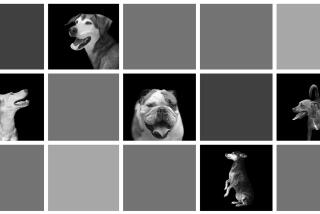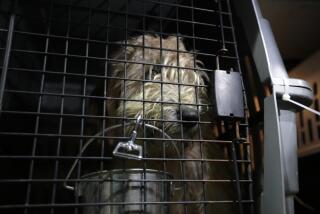Seeking Collar on Thieves
- Share via
An armed robbery in which three bulldog puppies were taken over the weekend has affirmed what bulldog lovers have feared for a while now: The wrinkly, droopy breed has become the latest, er, hot dog of choice.
The stolen pups, still unnamed but worth as much as $1,500 each, were nabbed Sunday from the home of a Westchester breeder whose brother and a roommate were held at gunpoint. A fourth bulldog, an adult male named Max, was taken from a Rancho Cucamonga backyard last Friday while its owners were away.
It’s unclear whether the same ring is responsible for both incidents, police said, but a flurry of bulldog thefts in recent months has put breeders on edge and has left World Wide Web sites crackling with anxiety and offers of rewards.
“It’s like something out of ‘101 Dalmatians,’ or in this case, bulldogs,” said Madeline Bernstein, president of the Society to Prevent Cruelty to Animals, in Los Angeles.
Although dognappings at gunpoint remain a rarity, animal theft has become more common in a market where fads come and go and thieves can bank on the sale of a popular, pedigreed pooch.
“Last year it was boxers,” Bernstein said.
Jim Walsh, a Sylmar breeder who formed a bulldog rescue network last year after losing two of his own pups to theft, agreed, saying, “There has been an increase of the popularity of the dogs. These things go in cycles. Sometimes it’s Rottweilers, other times the Doberman pinschers are the dogs everyone wants to have.”
The bulldog’s cachet apparently has been enhanced by a recent TV commercial for the Nissan Pathfinder that features one of the short-legged, snub-nosed dogs hawking the sport utility vehicle.
Scott Sentonaris certainly never thought himself at risk when he moved in with a bulldog breeder and his brother.
But on Sunday, the 25-year-old Sentonaris found himself with a handgun at his chin as two men posing as interested buyers grabbed the three English bulldog pups. The robbers apparently found the house, owned by Michael Landman, through the classifieds, police said.
“When I asked them to come back later they said, ‘Can we please see the dogs? We drove all the way from Ontario,’ ” Sentonaris said. So he let the two men into the house to play with the dogs.
Soon the men asked if they could offer $700 as a down payment.
As Sentonaris turned toward the phone to call Landman for permission, he felt cold metal against his face and heard the words:
“Get down on the floor [expletive deleted]! We’re stealing your dogs.”
*
The thieves used duct tape to tie up Sentonaris and Phillip Landman, Michael’s brother, before running off with the goods--and the electronic scanner used by the breeder to identify his puppies, all of which had microchips implanted in their necks.
Det. Chuck Worthen of the Los Angeles Police Department’s Pacific Area Division said it is highly unusual for a dog to be the main object taken in an armed robbery.
“I’ve never heard of that before in my life,” he said.
Police are still investigating the case, but cautioned bulldog breeders to be wary of giving their addresses.
In the Rancho Cucamonga heist, breeders Charly and Stacie Beightol also were contacted by a purported buyer who had read about their new litter of bulldog puppies in the classifieds.
A man calling himself Robert and driving a blue El Camino stopped by Friday afternoon to look at the young dogs, but left without offering to buy one.
That evening, when the Beightols were out, someone took Max, the puppies’ valuable purebred father, from the backyard. The puppies remained untouched inside the house. The Beightols said a neighbor saw a blue El Camino driving away.
“They took away a member of my family,” Charly Beightol said.
According to Walsh and police reports, an average of two bulldogs disappear each month in the area; the total value of the dogs stolen is placed at $20,000 each year.
Walsh said the dogs are coveted because it is difficult and expensive to breed them. Bulldog litters typically consist of no more than three puppies.
“If there’s a demand for the animal, people will do a lot of crazy things to get one,” he said.
Walsh said stolen dogs can sell for $200 to $700.
“It’s a bargain for the buyer, and pure profit for the thief,” he said.
Other reasons bulldogs are popular with thieves are that they are docile, easily portable and easier to trade for cash than, for example, a car, the SPCA’s Bernstein said.
“But I would hope people treat any merchandise sold on the street with skepticism,” she added. “If you see a bulldog being sold for $200 on the street, it’s probably stolen.”
*
Bulldogs are not only vulnerable to theft, but also easily contract upper-respiratory ailments and are high-maintenance animals.
“I don’t think these people are really aware of what they got themselves into,” said Peggy Breckley, editor of a newsletter for the Pacific Coast Bulldog Club, which has about 500 members in Southern California.
Breckley, who bred the dog that starred in the television series “Jake and the Fatman,” said bulldogs are not for everyone.
“I mean they’re not like your everyday golden retriever. They’re docile animals that need good owners to take care of them,” she said.
The bug-eyed creatures may be expensive to buy, breed and maintain, but owners are unanimous in support of the sentiment expressed by Stacie Beightol.
“I just want my dog back,” she said.
(BEGIN TEXT OF INFOBOX / INFOGRAPHIC)
Dogs in Demand
Like cars, certain breeds of dogs are vulnerable to theft because of consumer demand.
*
Five most stolen breeds of dogs
in alphabetical order.
* Doberman Pinscher
* English Bulldog
* German Rottweiler
* German Shepherd
* Pit Bull Terrier
*
Protecting your pet
* Check your yard fence regularly for new escape routes.
* Keep fence gates locked.
* Leash your dogs at all times.
* Always use a pet carrier for transport
* Yskr photos of your pet.
* Use identifiation tags and the microchip pet ID system.
*
Microchip Pet Identification
Nicrochip echnology helps identify animals that are not wearing tags. How it works:
1. The grain-sized microchip, containing owner information, is injected under the skin.
2. Impounded pets are scanned for the microchip information, which is used to trace the owners.
Source: SPCA
More to Read
Sign up for Essential California
The most important California stories and recommendations in your inbox every morning.
You may occasionally receive promotional content from the Los Angeles Times.










